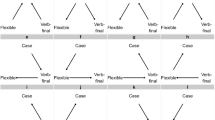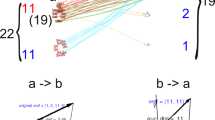Abstract
Human language is based on grammatical rules1,2,3,4. Cultural evolution allows these rules to change over time5. Rules compete with each other: as new rules rise to prominence, old ones die away. To quantify the dynamics of language evolution, we studied the regularization of English verbs over the past 1,200 years. Although an elaborate system of productive conjugations existed in English’s proto-Germanic ancestor, Modern English uses the dental suffix, ‘-ed’, to signify past tense6. Here we describe the emergence of this linguistic rule amidst the evolutionary decay of its exceptions, known to us as irregular verbs. We have generated a data set of verbs whose conjugations have been evolving for more than a millennium, tracking inflectional changes to 177 Old-English irregular verbs. Of these irregular verbs, 145 remained irregular in Middle English and 98 are still irregular today. We study how the rate of regularization depends on the frequency of word usage. The half-life of an irregular verb scales as the square root of its usage frequency: a verb that is 100 times less frequent regularizes 10 times as fast. Our study provides a quantitative analysis of the regularization process by which ancestral forms gradually yield to an emerging linguistic rule.
This is a preview of subscription content, access via your institution
Access options
Subscribe to this journal
Receive 51 print issues and online access
$199.00 per year
only $3.90 per issue
Buy this article
- Purchase on Springer Link
- Instant access to full article PDF
Prices may be subject to local taxes which are calculated during checkout



Similar content being viewed by others
References
Chomsky, N. Aspects of the Theory of Syntax (MIT Press, Cambridge, 1965)
Lightfoot, D. The Development of Language: Acquisition, Change and Evolution (Blackwell, Oxford, 1999)
Clark, R. & Roberts, I. A computational model of language learnability and language change. Linguist. Inq. 24, 299–345 (1993)
Abrams, D. & Strogatz, S. Modelling the dynamics of language death. Nature 424, 900 (2003)
Nowak, M. A., Komarova, N. L. & Niyogi, P. Computational and evolutionary aspects of language. Nature 417, 611–617 (2002)
Hooper, J. in Current Progress in Historical Linguistics (ed. Christie, W.) 95–105 (North-Holland, Amsterdam, 1976)
Hauser, M. D., Chomsky, N. & Fitch, W. T. The faculty of language: what is it, who has it, and how did it evolve? Science 298, 1569–1579 (2002)
Chomsky, N. & Lasnik, H. in Syntax: An International Handbook of Contemporary Research (ed. Jacobs, J.) 506–569 (de Gruyte, Berlin, 1993)
Dougherty, R. C. Natural Language Computing (Lawrence Erlbaum, Hillsdale, 1994)
Stabler, E. P. & Keenan, E. L. Structural similarity within and among languages. Theor. Comput. Sci. 293, 345–363 (2003)
Niyogi, P. The Computational Nature of Language Learning and Evolution (MIT Press, Cambridge, 2006)
Labov, W. Transmission and diffusion. Language 83, 344–387 (2007)
Pinker, S. Words and Rules: The Ingredients of Language (Basic Books, New York, 1999)
Kroch, A. Reflexes of grammar in patterns of language change. Lang. Var. Change 1, 199–244 (1989)
Kroch, A. in Papers from the 30th Regional Meeting of the Chicago Linguistics Society: Parasession on Variation and Linguistic Theory (eds Beals, K. et al.) 180–201 (CLS, Chicago, 1994)
Pinker, S. The irregular verbs. Landfall 83–85 (Autumn issue, 2000)
Bybee, J. Morphology: a Study of Relation Between Meaning and Form (Benjamins, Amsterdam, 1985)
Greenberg, J. in Current Trends in Linguistics III (eds Sebeok, T. A. et al.) 61–112 (Mouton, The Hague, 1966)
Bybee, J. From usage to grammar: the mind’s response to repetition. Language 82, 711–733 (2006)
Corbett, G., Hippisley, A., Brown, D. & Marriott, P. in Frequency and the Emergence of Linguistic Structure (eds Bybee, J. & Hopper, P.) 201–226 (Benjamins, Amsterdam, 2001)
Hare, M. & Elman, J. Learning and morphological change. Cognition 56, 61–98 (1995)
Marcus, G., Brinkmann, U., Clahsen, H., Wiese, R. & Pinker, S. German inflection: the exception that proves the rule. Cognit. Psychol. 29, 189–256 (1995)
Van der Wouden, T. in Papers from the 3rd International EURALEX Congress (eds Magay, T. & Zigány, J.) 363–373 (Akadémiai Kiadó, Budapest, 1988)
Zipf, G. K. Human Behavior and the Principle of Least Effort (Addison-Wesley, Cambridge, 1949)
Miller, G. A. Some effects of intermittent silence. Am. J. Psychol. 70, 311–314 (1957)
Yang, C. Knowledge and Learning in Natural Language (Oxford Univ. Press, New York, 2002)
Glushko, M. Towards the quantitative approach to studying evolution of English verb paradigm. Proc. 19th Scand. Conf. Ling. 31, 30–45 (2003)
Kroch, A. & Taylor, A. Penn-Helsinki Parsed Corpus of Middle English [CD-ROM] 2nd edn. (2000) 〈http://www.ling.upenn.edu/hist-corpora/PPCME2-RELEASE-2/〉
Acknowledgements
This work was supported by the John Templeton Foundation and by a grant from the NSF-NIH joint programme in mathematical biology. The Program for Evolutionary Dynamics is sponsored by J. Epstein. E.L. was supported by the National Defense Science and Engineering Graduate Fellowship and the National Science Foundation Graduate Fellowship. We thank S. Pinker, J. Rau, D. Donoghue and A. Presser for discussions, and J. Saragosti for help with visualization.
Author information
Authors and Affiliations
Corresponding author
Ethics declarations
Competing interests
The authors declare no competing financial interests.
Supplementary information
Supplementary Information
This file contains the main Supplementary Information for the paper with Supplementary Tables 1-7 and Supplementary Figures S1-S2 with Legends. It includes a table of all the irregular verbs found, as well as their frequency and relevant source text. It also provides a description of the Irregular equation, and Supplementary Discussion of the dynamics within rules and of changes in frequency since Middle English with additional references. (PDF 2657 kb)
Supplementary Data
This file contains Supplementary Data which is a tab-delimited text file containing all of the source data. (TXT 5 kb)
Supplementary Zip File
This file is a zipped version of all the Python source code, enabling the reader to browse the code and reproduce the results using the Supplementary Data as the sole input. (ZIP 162 kb)
Rights and permissions
About this article
Cite this article
Lieberman, E., Michel, JB., Jackson, J. et al. Quantifying the evolutionary dynamics of language. Nature 449, 713–716 (2007). https://doi.org/10.1038/nature06137
Received:
Accepted:
Issue Date:
DOI: https://doi.org/10.1038/nature06137
This article is cited by
-
Tone in politics is not systematically related to macro trends, ideology, or experience
Scientific Reports (2024)
-
Do searches on Google help in deterring property crime? Evidence from Indian states
Quality & Quantity (2024)
-
Signaling in an Unknown World
Erkenntnis (2023)
-
Network analysis of terms in the natural sciences insights from Wikipedia through natural language processing and network analysis
Education and Information Technologies (2023)
-
What Is a Solution of an Algebraic Equation?
International Journal of Science and Mathematics Education (2023)
Comments
By submitting a comment you agree to abide by our Terms and Community Guidelines. If you find something abusive or that does not comply with our terms or guidelines please flag it as inappropriate.



